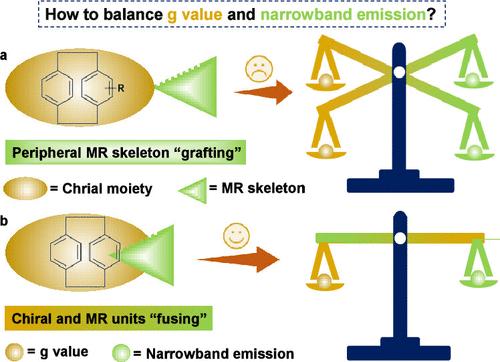基于手性副环环烷的增强远程电荷转移的高性能圆极化多共振TADF分子
IF 4.6
2区 化学
Q2 CHEMISTRY, PHYSICAL
引用次数: 0
摘要
圆极化多共振热激活延迟荧光(CP-MR-TADF)材料近年来受到广泛关注,但设计高性能的CP-MR-TADF发射器仍然是一个巨大的挑战,同时具有高量子效率,窄带发射和高不对称因子(g)。在这里,我们对基于[2.2]副环环烷(pCp)衍生物的CP-MR-TADF材料进行了深入的理论研究。由于过渡电偶极矩(TEDM)和过渡磁偶极矩(TMDM)的共轴占主导的跃迁分量增加了g值,但不可避免地导致窄带发射性能的损失。此外,通过将MR核的外围苯单元融合在平面手性pCp桥内,新设计的分子保持窄带发射,并表现出1 × 10-3的g值增加。这些发现对手性副环环酚类分子的结构-性能关系具有丰富的物理见解,为设计高性能手性材料提供了重要的线索。本文章由计算机程序翻译,如有差异,请以英文原文为准。

High-Performance Circular Polarization Multiple-Resonance TADF Molecules with Enhanced Long-Range Charge Transfer Based on Chiral Paracyclophane
Circularly polarized multiple-resonance thermally activated delayed fluorescence (CP-MR-TADF) materials have received widespread attention in recent years, but it remains a formidable challenge to design high-performance CP-MR-TADF emitters concurrently exhibiting high quantum efficiency, narrowband emission, and high dissymmetry factor (g). Here, we perform an in-depth theoretical investigation on the CP-MR-TADF materials based on [2.2] paracyclophane (pCp) derivatives. The MR-based materials with enhanced long-range charge transfer (LRCT) characteristics upon excitation show increased g values owing to the coaxial dominated transition components of the transition electric dipole moment (TEDM) and the transition magnetic dipole moment (TMDM) but inevitably result in the loss of narrowband emission performance. Furthermore, the newly designed molecules by fusing the peripheral benzene units of MR cores within the planar chiral pCp bridge maintain narrowband emissions and exhibit increased g values on the order of 1 × 10–3. These findings with rich physical insights on the structure–performance relation of chiral paracyclophane-based molecules should provide important clues for designing high-performance chiral materials.
求助全文
通过发布文献求助,成功后即可免费获取论文全文。
去求助
来源期刊

The Journal of Physical Chemistry Letters
CHEMISTRY, PHYSICAL-NANOSCIENCE & NANOTECHNOLOGY
CiteScore
9.60
自引率
7.00%
发文量
1519
审稿时长
1.6 months
期刊介绍:
The Journal of Physical Chemistry (JPC) Letters is devoted to reporting new and original experimental and theoretical basic research of interest to physical chemists, biophysical chemists, chemical physicists, physicists, material scientists, and engineers. An important criterion for acceptance is that the paper reports a significant scientific advance and/or physical insight such that rapid publication is essential. Two issues of JPC Letters are published each month.
 求助内容:
求助内容: 应助结果提醒方式:
应助结果提醒方式:


